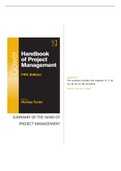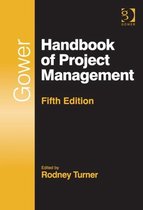Summary
Gower Handbook of Project Management Summary, ISBN: 9781472422965 Project Management Methods and Standards (MPM-PM-PMMS-22_1)
Institution
Hogeschool Utrecht (HU)
A summary of the following chapters of the handbook of project management (fifth edition): 6, 7, 10, 14, 15, 16, 17, 18, 22, 25.
Made for the course Project management methods en standards (PMMS) and agile en hybrid project management (AHP) for the master project management in the Netherlands (...
[Show more]
Last document update: 1 year ago
Preview 4 out of 62 pages
Summarized whole book?
No
Which chapters are summarized?
Chapter, 6, 7, 10, 14, 15, 16, 17, 18, 22, 25
Uploaded on
October 7, 2022
File latest updated on
April 4, 2023
Number of pages
62
Written in
2022/2023
Type
Summary
progressive elaboration
scope creep
defining scope
wbs
pbs
work packages
configuration management
life cy
managing scope and configuration
scope definition chain and errors
scope identification errors
Book Title: Gower Handbook of Project Management
Author(s): Rodney Turner
Edition: 2014 ISBN: 9781472422965 Edition: 5
Summary
Summary of chapter 6 Gower Handbook of Project Management - Agile and Hybrid Project Management
Summary
Summary of chapter 7 'measuring performance' from the Gower Handbook of project management
Summary
Summary of the chapter 16 'managing cost and earned value' from Gower Handbook of project management
All for this textbook (11)
Institution
Hogeschool Utrecht (HU)
Education
Master projectmanagement
Course
Projectmanagement methoden en standaarden (MPMPMPMMS22_1)
All documents for this subject (16)
$7.76
Also available in package deal from $7.76
100% satisfaction guarantee
Immediately available after payment
Both online and in PDF
No strings attached
Also available in package deal (2)
Samenvatting Gower Handbook of Project Management, ISBN: 9781472422965 Projectmanagement methoden en standaarden (MPM-PM-PMMS-22_1)
1. Summary - Samenvatting gower handbook of project management, isbn: 9781472422965 projectmanage...
2. Summary - Chapter 10 'managing scope and configurations' gower handbook of project management, ...
3. Summary - Chapter 14 'managing for stakeholders' gower handbook of project management, isbn: 97...
4. Summary - Chapter 15 'managing the schedule' gower handbook of project management, isbn: 978147...
5. Summary - Chapter 17 'managing resources' gower handbook of project management, isbn: 978147242...
6. Summary - Chapter 18 'managing risk' gower handbook of project management, isbn: 9781472422965
7. Summary - Chapter 22 'project start-up' gower handbook of project management, isbn: 97814724229...
8. Summary - Chapter 25 'project close-out' gower handbook of project management, isbn: 9781472422...
9. Summary - Summary of the chapter 16 'managing cost and earned value' from gower handbook of pr...
10. Summary - Summary of chapter 7 'measuring performance' from the gower handbook of project manag...
11. Summary - Summary of chapter 6 gower handbook of project management - agile and hybrid project...
Show more
Voorbereiding op het vak Projectmanagement Methoden en Standaarden (PMMS) van MPM
1. Summary - Samenvatting gower handbook of project management, isbn: 9781472422965 projectmanage...
2. Summary - Chapter 10 'managing scope and configurations' gower handbook of project management, ...
3. Summary - Chapter 14 'managing for stakeholders' gower handbook of project management, isbn: 97...
4. Summary - Chapter 15 'managing the schedule' gower handbook of project management, isbn: 978147...
5. Summary - Chapter 17 'managing resources' gower handbook of project management, isbn: 978147242...
6. Summary - Chapter 18 'managing risk' gower handbook of project management, isbn: 9781472422965
7. Summary - Chapter 22 'project start-up' gower handbook of project management, isbn: 97814724229...
8. Summary - Chapter 25 'project close-out' gower handbook of project management, isbn: 9781472422...
9. Summary - Samenvatting self-study moduel ipma4.0
10. Summary - Samenvatting self-study module prince2
11. Summary - Samenvatting van de pp. sheets voor het vak pmms
12. Summary - Samenvatting van de self-study module pmc
13. Summary - Samenvatting prince2 ® 6de editie - pocket guide, isbn: 9789401805919 projectmanage...
14. Other - Voorbereiding op het tentamen pmms (projectmanagement methoden en standaarden) voor d...
Show more
This document is also available in parts:
Chapter 10 'managing scope and configurations' Gower Handbook of Project Management, ISBN: 9781472422965
Chapter 10 Gower Handbook of Project Management, ISBN: 2965
Quick View
Chapter 14 'managing for stakeholders' Gower Handbook of Project Management, ISBN: 9781472422965
Chapter 10 Gower Handbook of Project Management, ISBN: 2965
Quick View
Chapter 15 'managing the schedule' Gower Handbook of Project Management, ISBN: 9781472422965
Chapter 10 Gower Handbook of Project Management, ISBN: 2965
Quick View
Chapter 17 'managing resources' Gower Handbook of Project Management, ISBN: 9781472422965
Chapter 17 Gower Handbook of Project Management, ISBN: 2965
Quick View
Chapter 18 'managing risk' Gower Handbook of Project Management, ISBN: 9781472422965
Chapter 18 Gower Handbook of Project Management, ISBN: 2965
Quick View
Chapter 22 'project start-up' Gower Handbook of Project Management, ISBN: 9781472422965
Chapter 22 Gower Handbook of Project Management, ISBN: 2965
Quick View
Chapter 25 'project close-out' Gower Handbook of Project Management, ISBN: 9781472422965
Chapter 25 Gower Handbook of Project Management, ISBN: 2965
Quick View
Summary of the chapter 16 'managing cost and earned value' from Gower Handbook of project management
Summary of the chapter 16 'managing cost and earned value' from Gower Handbook of project management
Quick View
Summary of chapter 7 'measuring performance' from the Gower Handbook of project management
Summary of chapter 7 'measuring performance' from the Gower Handbook of project management
Quick View
ABSTRACT





